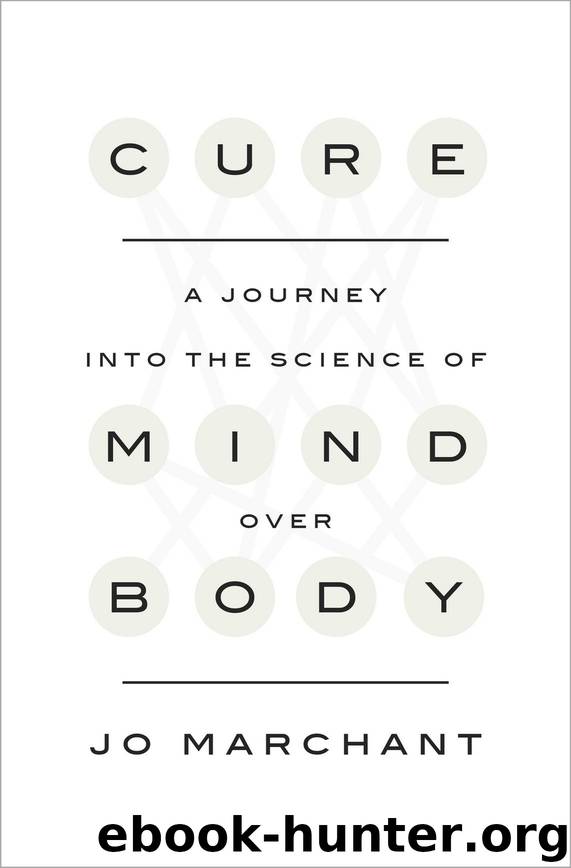Cure: A Journey into the Science of Mind Over Body by Marchant Jo

Author:Marchant, Jo [Marchant, Jo]
Language: eng
Format: azw3
ISBN: 9780385348157
Publisher: Crown/Archetype
Published: 2016-01-18T16:00:00+00:00
It’s seven in the morning and I’m walking along the beach in Santa Monica, California. The low sun glints off the waves and the clouds are still golden from the dawn. Curlews and sandpipers cluster on the damp sand, while in the distance, white villas of wealthy Los Angeles residents dot the Hollywood Hills.1
For half a mile or so, the beach is close to deserted. Then, just north of lifeguard station 27, I find what I’m looking for. In a neat line, a few yards back from the water’s edge, a handful of people sit cross-legged on towels. They’re members of a local Buddhist group, about to begin an hour-long silent meditation. I take my place at the end of the row, facing out to sea.
For centuries, followers of Eastern religious traditions have meditated in search of spiritual enlightenment. The practice came to the West in the 1960s as part of hippie counterculture, endorsed by celebrities and bands such as the Beatles and the Doors. Since then it has grown in popularity as people seek peace and meaning amid the material concerns of modern life; it now seems no more notable to see meditators on a California beach than in a temple in Tibet.
I’m not here on a spiritual quest, however. I’m interested in scientific claims that meditating can improve physical and mental health by reducing stress. Of all areas of mind–body medicine, meditation, with its close links to religion and spirituality—not to mention mind-expanding drugs—has had a stormy relationship with science. Various studies since the 1970s have suggested that meditating monks can achieve a range of striking physical effects, from voluntarily reducing blood pressure to flooding their brains with highly synchronized electrical waves.
Some researchers, with close links to religious organizations, have been accused of finding what they want to see. And although monks who have spent much of their lives in remote retreats are undoubtedly capable of some stunning feats, it’s not clear how relevant that is for the rest of us. In the last decade or so, however, a new generation of brain imaging studies and clinical trials has put meditation firmly on the scientific map. They’re showing that although watching our thoughts might seem ephemeral, it can have hard physical effects on our brains and bodies.
But first, it’s time to give this mysterious practice a try. There are hundreds of ways to meditate: compassion meditation involves extending feelings of love and kindness to fellow living beings (we’ll learn more about this in chapter ten); transcendental meditation has people focus on a repetitive mantra. Mindfulness, meanwhile, involves being aware of your own thoughts and surroundings. This is one of the most popular—and most studied—practices, so this morning I try a form of mindfulness meditation called open monitoring. Sit upright and still, and notice any thoughts that arise. Don’t judge or react to them, just let them go.
I settle on my towel and start to contemplate the sparkling water. The view stretches out over thousands of miles of Pacific Ocean, and it is breathtakingly beautiful.
Download
This site does not store any files on its server. We only index and link to content provided by other sites. Please contact the content providers to delete copyright contents if any and email us, we'll remove relevant links or contents immediately.
Inner Engineering: A Yogi's Guide to Joy by Sadhguru(6446)
The Power of Now: A Guide to Spiritual Enlightenment by Eckhart Tolle(5345)
Fear by Osho(4496)
Ikigai by Héctor García & Francesc Miralles(3900)
The Art of Happiness by The Dalai Lama(3851)
The Ultimate Bodybuilding Cookbook by Kendall Lou Schmidt(3713)
Yoga Therapy by Mark Stephens(3577)
The Little Book of Hygge by Meik Wiking(3449)
Why Buddhism is True by Robert Wright(3290)
The Healing Self by Deepak Chopra(3265)
Being Aware of Being Aware by Rupert Spira(3087)
The Hatha Yoga Pradipika (Translated) by Svatmarama(3078)
Shift into Freedom by Loch Kelly(3031)
Wild Words from Wild Women by Stephens Autumn(2939)
Work Clean by Dan Charnas(2902)
Happiness by Matthieu Ricard(2886)
More Language of Letting Go: 366 New Daily Meditations by Melody Beattie(2851)
Yoga Body & Mind Handbook by Jasmine Tarkeshi(2751)
Why I Am Not a Feminist by Jessa Crispin(2587)
